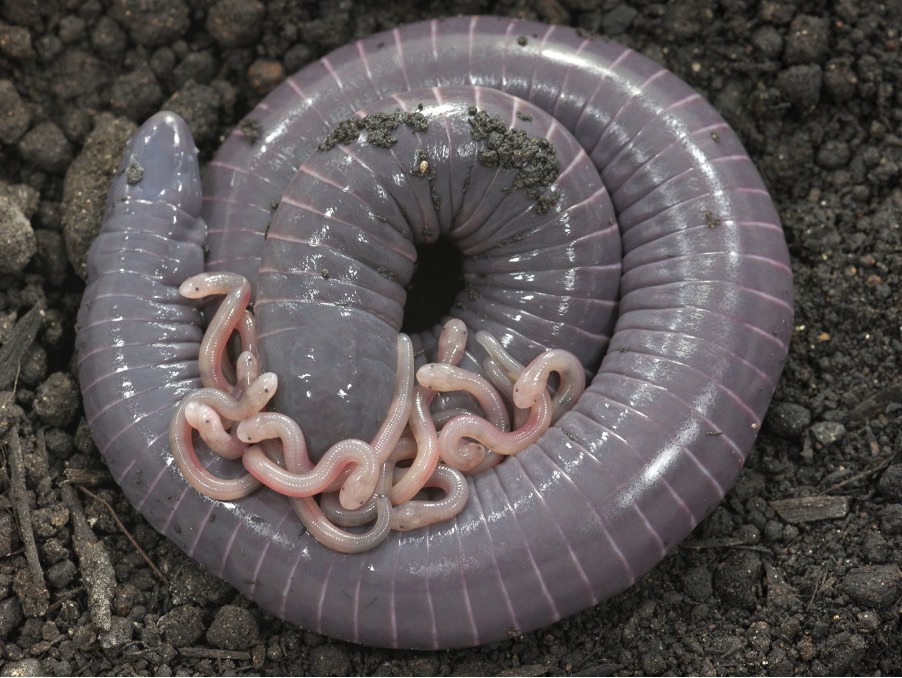By Kelly Hopkinson
This piece first appeared as a featured article in volume 95, issue three of Pelican. You can view our print archive here.
How do you like your coffee? Oat milk latte? Skinny cap? Lactose free? Full cream? Or maybe something a bit more exotic. Milk production has long been considered a uniquely mammalian trait, but this trait might not be so unique after all.
In the depths of the Amazon Rainforest, in a humid nest in the undergrowth, a cluster of tiny pink babies nuzzle at their mother for the first time. However, these are not cuddly newborn cubs and there are no udders or teats to latch onto. These baby earthworm-like amphibians get milk-drunk from a nutrient rich substance secreted from their mother’s reproductive tract.
Looking like something out of a science fiction film, caecilians are legless, burrowing amphibians that are found in tropical rainforests worldwide. With beady eyes, segmented bodies, and sensory tentacles on their faces, these creatures are no stranger to weird adaptations. Caecilians are very hard to find as they spend the majority of their lives underground, which means they are the least studied group of terrestrial vertebrates on earth. When scientists first discovered these creatures in the 1700s, they were mistaken for snakes, however their closest relatives are actually frogs and salamanders. Reproductive biology of caecilians is remarkably diverse considering there are only about two hundred known species worldwide. Caecilians display multiple different modes of reproduction. This means some species will give birth to live young while some lay a clutch of eggs.
Parental care is an attribute often associated with mammals. The young are born undeveloped and unable to fend for themselves, so mum steps in and helps, providing food, shelter, and protection until they reach independence. Caecilians have developed some bizarre parental care strategies unlike that of most amphibians. Some mothers go for a more laid-back approach while some will literally give the skin off their own back for their kids. No literally, some young eat the outer layer of their mother’s skin for sustenance.
Researchers in Brazil have recently studied a species of caecilian called Siphonops annulatus. This species not only lays eggs, but also exhibits extremely high levels of parental care, providing its young with a meal of fleshy epidermis and a latte of nutrient dense amphibian milk. This previously unobserved behaviour means these noodle-like creatures are the first egg laying amphibians to feed their offspring milk. During the larval stage of this species, the hatchlings will call out for their mother’s milk using a series of squeaks and clicks. This is thought to signal the mother to start lactating from within its reproductive tract or oviduct. The mother will then remain entirely dedicated to the hatchlings during the first two months of the baby’s lives and will not leave their side to even feed herself and loses 30 percent of her body mass!
However, the question that arises is whether this is real milk. Morphological analysis of the milk found that it is nutrient dense with carbohydrates and lipids, much like mammalian milk. This might help explain why baby caecilians grow so fast within the first week of life – increasing by a whopping 130 percent. This milk is also believed to aid in transferring essential antibodies and microbes to the offspring, thereby boosting their immune system health – like mammalian offspring.
Scientists still have a lot of questions about caecilians. Where did amphibian milk come from? How did this trait evolve? Why is the composition of the milk so like that of mammals? Will we be having amphibian milk in our cappuccinos soon? By answering these complex questions about life’s evolutionary mysteries, we can understand why similar adaptations – like milk production – have evolved separately in different species.
Biologists are developing new methods to study these elusive amphibians. With creative fieldwork techniques, these studies will be increasingly vital to understanding caecilian survival and their biodiversity on this planet. With more people being intrigued by these peculiar creatures it’s no wonder we are learning more about earth’s enigmas every day.

